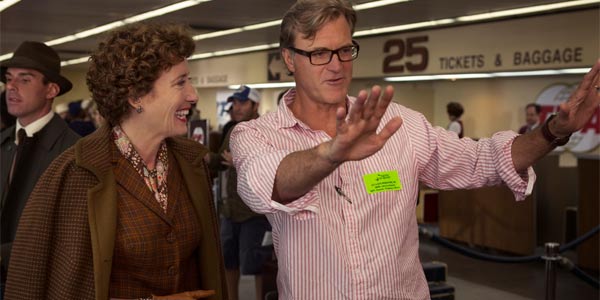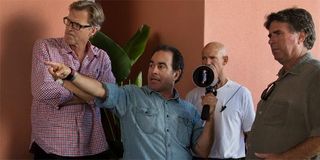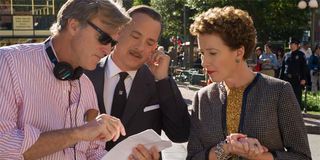Saving Mr. Banks Director John Lee Hancock Searches For The Factual And Emotional Truth

It’s around this time of year nearly every year that critics begin to try and uncover the real history behind Oscar contender films that are based on true stories. In recent years filmgoers have noted inaccuracies in titles like David Fincher’s The Social Network, Tom Hooper’s The King’s Speech, and even Bennett Miller’s Moneyball, and each time it brings back the debate of what the truth really means in adaptations and reenactments. Is it more important to nail the cold hard facts, or is it more about creating a story and discovering an emotional reality that may look at everything from a new angle? As the director of many "based on a true story" films, including the new movie Saving Mr. Banks, John Lee Hancock is very familiar with this conversation.
As part of a press day for the film late last month in Los Angeles, I had the opportunity to sit down one-on-one with Hancock and discuss what truth really means both in the context of feature filmmaking and in bringing the story behind the film Mary Poppins to life. Where do you find the line between emotional and factual truth? Read on to find out the director’s thoughts on the subject.
Something I always think about whenever I watch movies based on a true story, is the line between factual truth and emotional truth. Just having directed as many "based on a true story" films as you have, I’m curious what your personal philosophy is in that respect.
You know, it’s kind of like, what was the old supreme court saying about the decision about pornography, you know it when you see it. It’s a little bit of that. You know when you say this is fair or this is pushing the boundary, but I think you’re right about the emotional truth. Willie Morris, I produced a movie many years back called My Dog Skip and Willie Morris was on the set with us, and he wrote the book, very talented southern writer and Diane Lane was cast as his mother and you know, Diane’s much prettier than Willie’s mom was, so there are lots of those kinds of things in there and I asked Willie about it one time. I said, you know, we took stories from your entire six through eighteen and made it one year, condensed that and added other stories that kind of didn’t happen but could have, and he said, John, there are the facts and then there’s the truth and this is the truth, and he’s talking about an emotional truth. So, I think that’s the litmus for it, in a way.
What was your approach to that when you were looking at this film?
Well, the first thing you do is you always want to know, what really happened, what didn’t, what’s been shifted around. I didn’t write the script, so I didn’t know where the bodies were buried, so bringing Kelly in and saying did this happen, did this happen, just knowing, and then you can make a decision about, yeah I’m completely fine with flipping the order of these. Yes, this happened five years earlier, but it happened, so we’re going to put it in here.
How much does having research materials… you had [classic Disney composer] Richard Sherman as an asset on this film…
CINEMABLEND NEWSLETTER
Your Daily Blend of Entertainment News
He’s a living walking archive [laughs].
[Laughs] When it comes to the recordings and all of the records, how much does that influence the need to stick to the facts – knowing that the cold hard facts are out there.
Well, I think you use it all, because a lot of times, you’ll know emotionally what a story needs to be and you’ll go through that and find the things that help you tell that story and the more pieces of absolute reality you can bring in to it, it kind of seeps into the DNA of the project, in a weird way, whether it’s having the work project and swatches and stuff, Tony Walton’s sketches on the wall, cause it’s a movie about the creative process and not the finished product, but getting there.

You had access to a lot of information for the P.L. Travers/Walt Disney side of the story, but the story of Travers’ childhood in Australia, that’s not as well known about. When you were approaching that half of the story, did you feel you had a bit more freedom?
Yeah, you do, because I think the idea behind it, I mean, we know that these things happened. The father is an alcoholic and died and the mother tried to kill herself in the river and on and on and on. We have all of these basic facts. They moved from Maryborough to Allora and Aunt Ellie, when you read about her, she does seem like, well that’s the origin story for Mary Poppins, so that’s kind of loosely there, but the idea for this, that Kelly wrote and that we continued to talk about was that P.L. Travers, you want to get to a place where she’s not necessarily a reliable narrator, because the Sherman brother’s lyrics are entering her father’s mouth, and so it’s very much about not too different planes of 1906 and 1961 going along like that, but kind of strands of that DNA just crossing over and over again and hopefully adding up to more than the sum of their parts. So, you know, and then it allows you to have a little more stylized version of childhood memories, because mine certainly are. You remember an uncle which you swear was 6’ 7" and then you meet him and he’s 5’9" and you go, that’s not what I remember.
That’s the emotional truth.
It is, and also I love the idea and it saddens me in a great way from a character standpoint that she, as a child, who wouldn’t want someone to come and fix my family, and sometimes families can’t be fixed, and so what do you do with that. You turn it into a book where somebody can come in and fix this and then for 20 years, not only Disney, but other studios, trying to buy the rights and there’s a part of you where you’re saying no, no, no, no, no and deep down it’s because you don’t want to go there again, because I already took care of that problem. You’re asking me to open up that box again and I have no idea what’s going to come out.
Where does objectivity enter into it, from your perspective? Do you have to free yourself from judgment of these people, being that they’re real and this is their story?
That’s a really good question. I think there’s a certain responsibility to real characters, no doubt about it, but, and being, you don’t have to be sympathetic to them. You just have to, you do have to be, how can I put this? You don’t have to be sympathetic to them, but you have to be sympathetic to their plight in a weird way, and what they’re going through. It was funny. I had a long conversation with Vince Gilligan about characters that are created that refuse to come to you as an audience. They refuse to bend towards you to become more likable, more accessible and over time, you find yourself leaning toward them, and in P.L. Travers and Walter White and it was like, that’s really interesting, because she doesn’t change a bit, but by the end, hopefully, because we’ve seen this journey and we understand it more, we don’t have to love her, we just have to be fascinated by her complexities.

Does that mean you have to completely take judgment out of it?
No, I don’t think so. I think, to a point. Now, the thing is, from an actor’s standpoint, and they’re playing a character, they have to look at it as, I have to justify all of these things, so this horrible thing, in my mind, I have to justify it. So, I prefer for the actors to deal with all that and for me to pass judgment more on the story. That’s not to say you can’t help them along in one direction or the other, but yeah, I don’t know. Everybody has to be the hero in the story in a weird way. I told Bradley Whitford, I go, "You’ve been around a long time. Let me tell you a secret. This is Don DaGradi’s movie."
There’s also the inescapable fact that this is a story about Walt Disney and it’s a film being made by the Walt Disney Company… where does that pressure come on you as a filmmaker?
It does. I don’t think the movie could have been made inside Disney. It had to create, to become fully grown as a script, completely outside, with BBC and Australia and Hopscotch and Ruby films and everybody else and then chuck it over the wall at Disney and then unbelievably, they go yes, when it would have been the smart business move would have been to say no. There’s no doubt about it. I don’t think it could have been developed within the walls, because I think even with the best of intentions, thy would have chipped away at Walt and he would become, you know, you want to think of your grandfather as a god instead of a human being with flaws, and sometimes somebody else can look and tell you more about your own relations than you can, than you can know about him. I always thought it was fair. I was still worried always, that at the eleventh hour Disney was going to come in and say let’s cut this, this, and this, and it was going to kill me. I was ready for war. I mean, and I like those guys, but I was ready for war, and it never came to that.
How much did the script change from the first draft that you got to what we see in the final cut?
Not dramatically, I mean, it was more working within the confines of what was there. We probably cut a couple of scenes or said, do we need this. This seems like a duplicate emotional beat. Those kinds of things that naturally happen, that shake out during prep. Also, just the fun stuff of prep, I mean, having Kelly here from Namibia and said you’ve got to be here, because when I’m talking about paint color on walls, that’s a character choice. When I’m talking about jewelry for a character, that’s a character choice, and I want to hear what’s in your mind’s eye. We don’t have to agree and you can also say I had never thought of it, but I want you there, because sometimes you never thought of it, and you go, oh, but that means something to me. so, you get the connective tissue going, and also just sitting and watching Mary Poppins with her three or four times, scene by scene and going how can we cross pollinate 1906 Australia, P.L. Travers’ childhood, the book’s Mary Poppins, P.L. Travers in 1961 and the movie that resulted from it. Let’s cross-pollinate all four of those things until it’s this, so we put a lot of stuff in.

Eric Eisenberg is the Assistant Managing Editor at CinemaBlend. After graduating Boston University and earning a bachelor’s degree in journalism, he took a part-time job as a staff writer for CinemaBlend, and after six months was offered the opportunity to move to Los Angeles and take on a newly created West Coast Editor position. Over a decade later, he's continuing to advance his interests and expertise. In addition to conducting filmmaker interviews and contributing to the news and feature content of the site, Eric also oversees the Movie Reviews section, writes the the weekend box office report (published Sundays), and is the site's resident Stephen King expert. He has two King-related columns.
Most Popular







